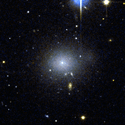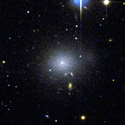Do dark matter particles interact?
Precise cosmological observations suggest that about three-quarters of the mass-energy of the universe is a poorly understood “dark energy” that drives an overall expansion. Most of the remainder is called “dark matter,” which interacts with light and ordinary matter only through its gravity. The clumpiness of dark matter in the early universe, still recorded in tiny variations in the microwave background, is thought to have seeded the coalescence of matter into the cosmological structures we see today.
Since dark matter is also usually thought to interact with itself only through the gravitational force, simulations predict that it will pile up dramatically within all large clumps of matter. This sharply peaked dark-matter distribution matches that inferred from observations of clusters of galaxies. But in “small” structures, such as dwarf galaxies, the dynamics of stars indicate instead a more spread-out core. In a paper appearing in Physical Review Letters, Abraham Loeb of Harvard and Neil Weiner of New York University suggest that cores of dark matter, as opposed to peaks, arise if dark-matter particles scatter one another. This idea was proposed a decade ago, but failed to explain why larger structures have no core. Now, Loeb and Weiner show that, if the interaction (which for now has an unknown origin) has a finite range, it has a weaker effect on particles moving rapidly relative to each other, which they are expected to do in large structures but not in the smallest ones. – Don Monroe





